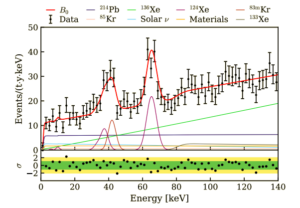The XENON experiment in Gran Sasso that hunts for signs of dark matter has self-destructed an earlier anomaly in the data after intense scrutiny. The spike that appeared in the measurements at low energy was probably due to traces of tritium in the system.
This is what the international XENON collaboration writes this week in an article about the first measurements with an updated and expanded version of the earlier experiment. Nikhef is an important partner in XENON’s engineering and measurements.
XENON attempts to capture dark-matter particles from the universe by looking for flashes of light from collisions with xenon atoms. The detector full of liquid xenon is located under a kilometer of granite from the Gran Sasso Mountains in Italy in a giant water tank, to shield all other cosmic radiation.
Riddles
So far, the experiment has never found a clue to dark matter, but has ruled out more and more conceivable forms of dark matter. Dark matter is one of the riddles of physics. Fast-spinning galaxies are held together by invisible extra mass, but what it consists of is unknown.
In 2020, the collaboration reported that measurements with the previous version of the experiment, called XENON1T, showed a deviation at the very lowest measured energy. Several explanations seemed possible for this, from contamination with radioactive traces to indications of unknown particles such as axions, and possibly even dark matter.
Excitement
The latter led to some excitement in the media, but the researchers themselves remained extremely cautious. Further research had to show what could really be going on. This included traces of tritium, a radioactive gas that is created in nuclear reactions and in the atmosphere by cosmic radiation.
Since 2020, the underground detector has been rebuilt with a larger volume of usable liquid xenon and much better filtering systems. The new system, called XENONnT, has five times lower background noise than XENON1T and should therefore see an anomaly better. However, the earlier spike is not seen in the now published initial measurements with the larger detector, which indeed gives much lower background noise.
Tritium
The first measurements with XENONnT have already set another sharper limit on possible dark-matter particles. In the article about these measurements, the XENON physicists also describe how a systematic search was made for evidence of interference by tritium.

The new version of the experiment includes a much better filtering system for tritium contamination in the xenon used and the materials of the detector itself. The detector itself has been cleaned even more rigorously before use than in the earlier version. The tritium concentration has been reduced by at least a factor of ten.
Bittersweet
UvA physicist Patrick Decowski, leader of the Dark Matter group at Nikhef and closely involved in writing the new paper, calls the result bittersweet. “It has two sides. The good news is that the new larger detector will be better able to find any dark matter. But of course it’s still a shame that an exciting peak turns out to be nothing special after all.”
